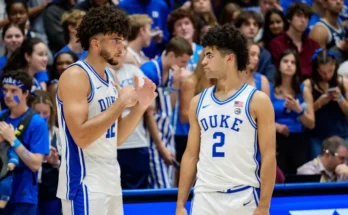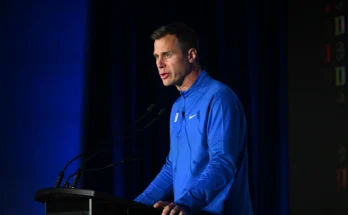The Pittsburgh Steelers, a franchise with a rich history and a reputation for excellence, recently found themselves grappling with the loss of a player many had high hopes for. The player in question is Jaray Jenkins, a former star wide receiver from LSU, who, after a brief stint with the team, was ultimately released. His departure has sparked discussions about roster strategies, the challenges of transitioning from college football to the NFL, and the nature of competition in the league. To understand the significance of Jenkins’ time with the Steelers, we need to examine his collegiate career, his journey into the NFL, and the factors that led to his departure from Pittsburgh.
Jaray Jenkins’ story begins at Louisiana State University (LSU), where he became a standout wide receiver. Over the course of his career with the Tigers, Jenkins demonstrated exceptional talent and ability. Known for his speed, route-running, and ability to make plays in clutch moments, Jenkins quickly became a favorite target for LSU quarterbacks. His collegiate resume includes 89 receptions for 1,370 yards and 14 touchdowns, making him one of the top receiving threats in the SEC. What made Jenkins particularly dangerous was his knack for making plays in critical situations. In his senior season, he had a memorable performance in a game against Texas A&M in 2021, catching eight passes for 169 yards and two touchdowns, including the game-winning score in the final moments. This kind of playmaking ability is what drew the attention of NFL scouts, and many expected him to have a successful transition into the professional ranks.
Despite his college success, Jenkins’ journey to the NFL wasn’t as smooth as he or many had hoped. After going undrafted in the 2023 NFL Draft, Jenkins faced an uphill battle to make a name for himself in the league. He initially signed with the Jacksonville Jaguars but found himself on injured reserve, missing his entire rookie season. This setback would have been disheartening for many, but Jenkins remained determined to prove himself. The Steelers, who were in need of depth at the wide receiver position, offered him a one-year contract in June 2024, giving him a second chance to showcase his skills at the highest level.
During the 2024 preseason, Jenkins had the opportunity to prove himself to the Steelers’ coaching staff. In three games, he recorded four receptions on five targets for 44 yards. While these numbers weren’t spectacular, they were enough to keep him in the conversation for a roster spot. However, despite his potential and the flashes of ability he displayed, Jenkins was ultimately waived by the Steelers in October 2024. The move was a disappointment for both Jenkins and the team, especially considering the high hopes many had for him when he first joined Pittsburgh.
To understand why Jenkins was released, it’s important to consider the dynamics of the Steelers’ wide receiver position. Over the past few seasons, Pittsburgh has had one of the most dynamic receiving corps in the NFL. With a star wide receiver in Diontae Johnson and other talented players like George Pickens and Chase Claypool, the Steelers were already well-stocked at the position. Additionally, Pittsburgh made a significant move in March 2024 by acquiring Van Jefferson, a proven wide receiver from the Los Angeles Rams, who was expected to provide an immediate impact. This move, combined with the emergence of other young receivers, meant that Jenkins was facing fierce competition for a spot on the roster. While Jenkins’ college pedigree made him an intriguing prospect, the Steelers had other players who were further along in their development and more in sync with the team’s offensive system.
The release of Jenkins also reflects the reality of NFL roster dynamics. Roster spots are limited, and teams must make difficult decisions about who stays and who goes. NFL coaches and general managers are always looking for the best fit for their team, not just in terms of raw talent, but also in terms of how a player meshes with the team’s culture, offensive philosophy, and long-term plans. In Jenkins’ case, the Steelers had to make the tough choice to move forward without him. This decision, while disappointing for Jenkins, is part of the harsh reality that many undrafted free agents face in the NFL. Even with impressive college resumes, the transition to the pros is never guaranteed.
While Jenkins’ tenure with the Steelers was brief, his potential as a wide receiver has not been lost. His time at LSU showcased the kind of playmaking ability that can be a difference-maker on the field. Despite his struggles in his rookie year and the cut from Pittsburgh’s roster, Jenkins remains a player with the skills to succeed at the NFL level. His size, speed, and ability to make tough catches in clutch moments give him the tools necessary to thrive. It’s not uncommon for players to be released by one team only to find success with another, and Jenkins could be one of those players. His journey is far from over, and his story is a testament to the perseverance required to succeed in the NFL.
Looking ahead, Jenkins will undoubtedly be searching for a new opportunity to prove himself. Whether that opportunity comes with another NFL team or in a different professional football league, Jenkins has shown the potential to be a productive player. His next move will be critical to his career, and it will be interesting to see how he adjusts to the next challenge. For players like Jenkins, the NFL is a land of opportunity, but it’s also a place where the margin for error is incredibly small. Success is never guaranteed, and a single mistake or missed opportunity can alter the trajectory of a career.
For the Pittsburgh Steelers, releasing Jenkins was a tough decision, but one that ultimately made sense given the state of their roster. The team has one of the deepest wide receiver corps in the league, and with the addition of Van Jefferson, they were able to fill the role Jenkins would have played. However, the Steelers’ decision also highlights the unpredictable nature of the NFL. One player’s loss could be another’s gain, and it remains to be seen if Jenkins will find success elsewhere.
The Steelers are no strangers to roster turnover, and they’ve built a reputation for developing talent and maintaining a competitive roster year after year. While Jenkins’ release is a disappointment, it’s also a reminder of how difficult it is to make it in the NFL. For every success story of a player making the team and becoming a star, there are countless others who fall short despite having the talent to succeed. The NFL is a league of constant evaluation, and players must continually prove their worth to stay relevant.
In conclusion, Jaray Jenkins’ time with the Pittsburgh Steelers may have been short-lived, but his story is far from over. The talented wide receiver from LSU had a promising collegiate career and showed flashes of potential during his time with the Steelers. However, the highly competitive nature of the NFL and the team’s depth at the wide receiver position ultimately led to his release. While this is a setback for Jenkins, it’s also a reminder of the challenges rookies face when transitioning from college football to the professional ranks. His next steps will be critical to his future in the NFL, and fans will be watching closely to see if he can overcome this obstacle and make a successful comeback. Regardless of where he ends up, Jenkins’ journey is a testament to the perseverance required to succeed at the highest level of football.



